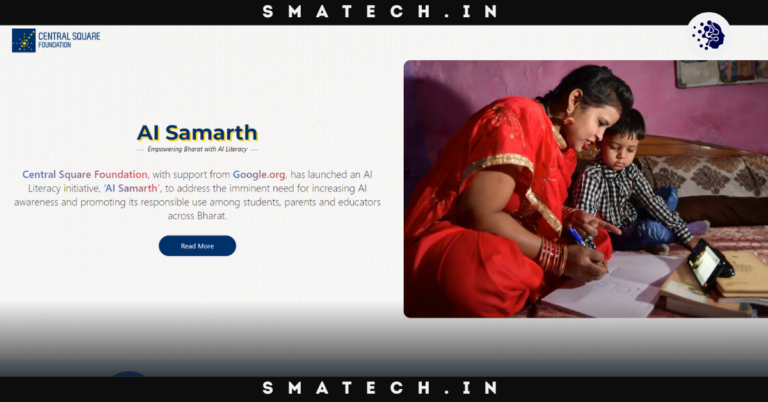The field of education is being drastically changed by artificial intelligence (AI), especially in India where technology breakthroughs are now seen as essential to the country’s progress and prosperity. Google’s ‘AI Samarth’ initiative is a ground-breaking program designed to enable millions of students, educators, and parents to embrace AI as a tool for improving education nationwide by fostering AI literacy. Over the next five years, the ambitious program aims to reach 1 million individuals to cultivate a generation that is not only capable of using AI to construct a better future, but also knows how to use it.
What is ‘AI Samarth’?
The Central Square Foundation (CSF) and Google are partners in the innovative project ‘AI Samarth‘. As part of Google’s ongoing efforts to increase technological accessibility, particularly for the underprivileged communities in India, this program was introduced. Fundamentally, AI Samarth aims to build a strong foundation for AI adoption and technology literacy by teaching AI literacy to a broad audience, including educators, parents, and students.
This initiative’s realization that AI skills are increasingly crucial for the workforce of the future is one of its main motivating drivers. Google wants to provide students and educators with the skills necessary to adapt to new technologies and take advantage of the employment opportunities that are emerging in AI-driven industries by promoting AI literacy.
Why AI Literacy is Crucial for India’s Future
Understanding artificial intelligence (AI) is very essential in today’s environment, as it becomes more and more digital. The ability to comprehend, apply, and even create AI technology is known as AI literacy. These technologies are becoming widely used in a variety of industries, including healthcare, agriculture, and education. Initiatives such as AI Samarth have the potential to break down the technological barriers that are present in India, where digital literacy is still limited in many regions, especially in rural areas and underserved communities.
Furthermore, AI literacy fosters creativity, critical thinking, and problem-solving abilities—qualities essential for success in any line of work. AI Samarth is laying the foundation for a more tech-savvy workforce by promoting AI literacy through training programs, outreach efforts, and education strategies. This will ensure that people from all backgrounds can benefit from AI and make a significant contribution to community empowerment and the digital economy.
Related Post
AI Samarth and Education: Transforming Learning Experiences
The AI Samarth initiative’s emphasis on education is among its most important features. In addition to educating students about AI, the program aims to provide educators with the skills and information needed to integrate AI into their pedagogy. With this dual focus, AI literacy is guaranteed to become an essential component of the education system, enabling students to engage with AI in ways that improve their learning experiences.
The program highlights the value of AI in education, especially in terms of enhancing accessibility and personalization of learning. AI-powered solutions can give students individualized learning experiences that are catered to their unique requirements and learning preferences. This is particularly critical in India, where access to high-quality education varies greatly based on one’s location and socioeconomic status.
With AI Samarth, Google and CSF seek to create equitable opportunities for all students, irrespective of their background, by offering them access to AI-driven learning solutions. This involves assisting students from government schools and teachers in actively participating in the AI ecosystem as well as consuming AI-driven content.

Empowering Teachers and Students with AI Skills
The AI Samarth initiative’s success depends on its capacity to provide teachers and students with the knowledge and abilities needed to prosper in a **world enabled by AI. The effort makes sure that the effects of *AI literacy* are extensive and long-lasting by concentrating on both groups. This entails giving students the knowledge and self-assurance they need to pursue jobs in artificial intelligence and other tech-related industries. It entails getting the skills and resources needed by educators to successfully incorporate AI into their classrooms and curricula.
Additionally, AI Samarth acknowledges that AI literacy encompasses not only the knowledge of how to use AI technologies but also the comprehension of the ethical consequences and responsible application of AI. This is especially crucial since artificial intelligence is becoming more and more integrated into our daily lives. AI Samarth is contributing to the formation of a generation that is not just AI-literate but also conscious of the societal and ethical issues surrounding AI by advocating for responsible AI adoption and challenging educators and students to reflect critically on the implications of AI.
Community Engagement and Outreach Efforts
The AI Samarth initiative places a strong emphasis on community engagement. Google and CSF are collaborating closely with local communities, schools, and government bodies to execute the program in a way that is impactful and accessible, to ensure that the advantages of AI literacy reach as many people as possible.
This entails holding online resources, holding seminars, and collaborating with neighbourhood groups to offer AI literacy training to rural and underserved communities. AI Samarth seeks to remove the technological barriers that frequently keep people in rural areas from having access to high-quality education and digital skills training by adopting a community-centred approach.
In addition, the project is meant to be scalable, to broaden its scope in the upcoming years. In addition to AI literacy for 1 million people, the objective is to build a sustainable model that can be reproduced in other nations and areas, therefore promoting a global movement towards digital empowerment and AI education.
The Long-Term Impact of AI Samarth
The AI Samarth initiative is anticipated to have a significant long-term impact. Through the initiative, AI skills are being imparted to communities, instructors, and students, preparing them for the opportunities and difficulties of the future workforce. Consequently, there will be a rise in employment opportunities, economic growth, and technology adoption across a range of industries.
Furthermore, rural education in India is expected to be significantly impacted by the project. AI Samarth is contributing to closing the digital divide and guaranteeing that people in remote locations have access to the same educational opportunities and resources as those in urban areas by offering AI literacy training to rural communities.
In the end, AI Samarth is an audacious and ambitious attempt to influence India‘s future workforce development and educational landscape. The initiative has the ability to change millions of people’s lives and establish a new benchmark for AI education globally as it grows.
Frequently Asked Questions (FAQs) about Google’s AI Samarth Initiative
1. What is the goal of the AI Samarth initiative?
The AI Samarth initiative aims to educate 1 million people about artificial intelligence, including parents, teachers, and students, with the goal of promoting AI literacy throughout India. In order to enable people to contribute to the developing digital economy, the program aims to provide them with the knowledge, skills, and abilities to comprehend, apply, and leverage AI technology in their professional and academic lives.
2. Who is AI Samarth aimed at?
The principal beneficiaries of AI Samarth are parents, teachers, and schoolchildren, particularly those from underserved communities in India. The program’s main objective is to give these groups AI literacy and skill training so they can accept AI responsibly and use it to workforce development and education.
3. How will AI Samarth benefit students and teachers?
AI Samarth provides students with the necessary AI skills to improve their educational experiences and create future job opportunities in AI-related fields. Conversely, teachers are trained to successfully incorporate AI into their teaching methods, enabling more individualized, accessible, and interesting learning for their pupils.
4. How does AI Samarth address digital literacy in rural areas?
With resources and training in AI literacy catered to rural and underserved communities, the AI Samarth initiative aims to dismantle technological barriers in these areas. The initiative conducts workshops, distributes online educational resources, and interacts with local groups to ensure that people in remote areas have access to excellent AI education.
5. What is the long-term impact of AI Samarth on India’s workforce?
Over time, AI Samarth hopes to develop a more tech-savvy workforce with the AI know-how needed to thrive in the digital economy. The initiative aims to improve employment opportunities, drive economic growth, and enhance technology adoption in many sectors across India. It does this by promoting AI literacy.























































